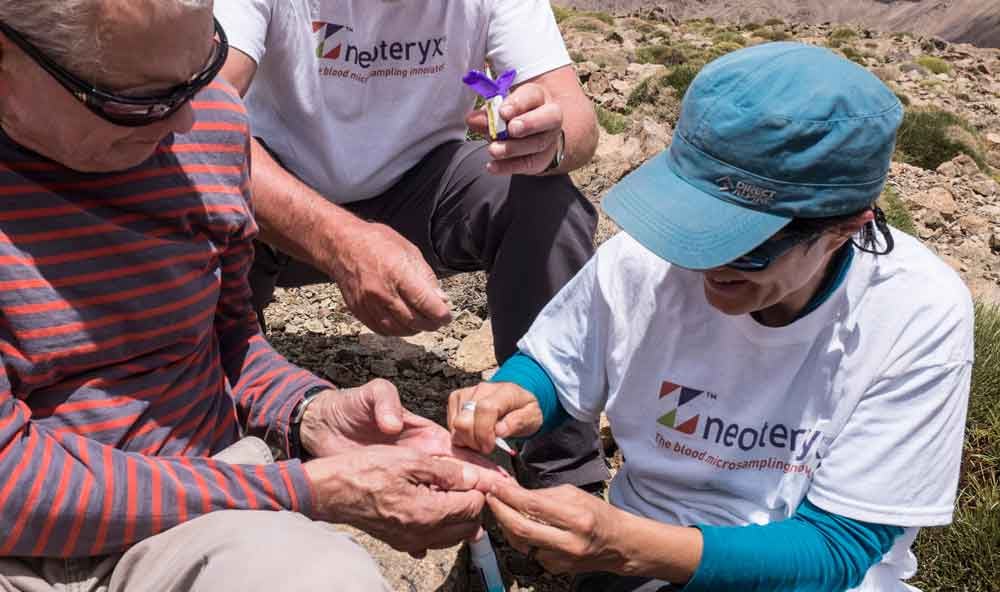Share this
smarter immunosuppressant monitoring: the promise of capillary blood microsampling innovation
by Neoteryx Microsampling on Dec 17, 2019 4:04:00 AM

For many organ transplant patients, immunosuppressant monitoring is a fact of life. They must take immunosuppressive drugs to ensure that their body doesn't reject the transplanted organ. However, therapeutic drug monitoring (TDM) can be significantly improved by enabling a remote, home-based approach. The remote blood sampling capabilities provided by Mitra® microsampling devices based on VAMS technology employ a volumetric absorptive microsampling approach that simplifies blood sampling.
With a handheld Mitra device that can be shipped to a patient at home in a Mitra Sample Collection Kit, nearly anyone, anywhere can easily collect finger-stick blood samples as part of a toxicology study or TDM program.
Therapeutic Drug Monitoring for Transplant Recipients
Immunosuppressant regimens for patients who have received kidney transplants or other organ transplants require precise levels of drugs to be present in the bloodstream at all times. To ensure the treatment is working, these levels must be strictly monitored, requiring blood sampling at frequent and regular intervals.
Under old ways of blood collection, the inconvenience posed by therapeutic drug monitoring for organ transplant recipients is obvious. Patients must travel to clinics, sometimes at great distances, spending time away from home and family. This can impose constraints on lifestyle, along with a more general sense of frustration.
The Promise of Remote Sampling
New blood microsampling technology allows organ transplant recipients to collect samples anywhere, at any time, with minimal training - an innovation known as remote blood collection. From the perspective of patient experience, this makes immunosuppressant monitoring a lot more manageable.
Organ transplant recipients, at home - or wherever they want to be - can self-sample and ship. They can also claim greater agency and participation in their own treatment, making them feel more invested in its success.
The Science is Solid
But does blood microsampling produce samples that generate the same high-quality data associated with the gold standard of venous blood? Until recently, the answer was ambiguous.
Older dried blood collection methods, such as DBS cards, produced imprecise volumes of dried blood, leading to the hematocrit bias compromising data. Plus, they were cumbersome and unpleasant for patients, not much of an improvement over painful venipuncture with needles.
VAMS® technology is different. Samples are volumetrically accurate. Self-sampling is considerably easier. And scientific results from third-party researchers prove that, with the right procedures in place, samples collected through microsampling generates results that correlate with those from plasma and venous blood.
Blood Microsampling in Tacrolimus Monitoring
There are still ample opportunities for researchers studying immunosuppressant monitoring for organ transplant patients to get involved with microsampling.
Success with tacrolimus monitoring has been remarkably promising. Scientists in the United Kingdom and Norway have shared their results, with more on the way.
This creates a model for how dried blood microsampling may expand to be applied to other immunosuppressant drugs and other analytes.
And what does that mean for patients?
New Possibilities for Organ Transplant Patients
Already, VAMS has enabled transplant patients to undertake a trek up Mt. Kilimanjaro, monitoring their immunosuppressant levels as they climbed. It has helped a pediatric kidney transplant patients stay closer to their families and communities.
And this is only the beginning. Like remote sampling itself, the biggest breakthroughs in using microsampling to monitor immunosuppressant drugs in transplant patients to ensure efficacy and reduce toxicity could happen anywhere. It could happen in a toxicology lab, clinical lab or your lab.
If you work with immunosuppressants, you need to understand how remote microsampling can benefit your patients or study cohorts. Contact us today, and one of our Microsampling Specialists will help you understand how to leverage the possibilities of this remarkable blood collection device.
More information about remote microsampling for TDM can be found via our Microsampling for Drug Monitoring page.
Smarter, simpler sampling is the solution for better immunosuppressant monitoring. Start the conversation today!

Image Credits: Trajan, Neoteryx, iStock, Shutterstock
Share this
- Microsampling (206)
- Research, Remote Research (119)
- Venipuncture Alternative (105)
- Clinical Trials, Clinical Research (83)
- Mitra® Device (73)
- Therapeutic Drug Monitoring, TDM (51)
- Dried Blood Spot, DBS (39)
- Biomonitoring, Health, Wellness (30)
- Infectious Disease, Vaccines, COVID-19 (24)
- Blood Microsampling, Serology (23)
- Omics, Multi-Omics (21)
- Decentralized Clinical Trial (DCT) (20)
- Specimen Collection (18)
- Toxicology, Doping, Drug/Alcohol Monitoring, PEth (17)
- Skin Microsampling, Microbiopsy (14)
- hemaPEN® Device (13)
- Preclinical Research, Animal Studies (12)
- Pharmaceuticals, Drug Development (9)
- Harpera Device (7)
- Industry News, Microsampling News (5)
- Antibodies, MAbs (3)
- Company Press Release, Product Press Release (3)
- Environmental Toxins, Exposures (1)
- July 2025 (1)
- May 2025 (1)
- April 2025 (2)
- December 2024 (2)
- November 2024 (1)
- October 2024 (3)
- September 2024 (1)
- June 2024 (1)
- May 2024 (1)
- April 2024 (4)
- March 2024 (1)
- February 2024 (2)
- January 2024 (4)
- December 2023 (3)
- November 2023 (3)
- October 2023 (3)
- September 2023 (3)
- July 2023 (3)
- June 2023 (2)
- April 2023 (2)
- March 2023 (2)
- February 2023 (2)
- January 2023 (3)
- December 2022 (2)
- November 2022 (3)
- October 2022 (4)
- September 2022 (3)
- August 2022 (5)
- July 2022 (2)
- June 2022 (2)
- May 2022 (4)
- April 2022 (3)
- March 2022 (3)
- February 2022 (4)
- January 2022 (5)
- December 2021 (3)
- November 2021 (5)
- October 2021 (3)
- September 2021 (3)
- August 2021 (4)
- July 2021 (4)
- June 2021 (4)
- May 2021 (4)
- April 2021 (3)
- March 2021 (5)
- February 2021 (4)
- January 2021 (4)
- December 2020 (3)
- November 2020 (5)
- October 2020 (4)
- September 2020 (3)
- August 2020 (3)
- July 2020 (6)
- June 2020 (4)
- May 2020 (4)
- April 2020 (3)
- March 2020 (6)
- February 2020 (3)
- January 2020 (4)
- December 2019 (5)
- November 2019 (4)
- October 2019 (2)
- September 2019 (4)
- August 2019 (4)
- July 2019 (3)
- June 2019 (7)
- May 2019 (6)
- April 2019 (5)
- March 2019 (6)
- February 2019 (5)
- January 2019 (8)
- December 2018 (3)
- November 2018 (4)
- October 2018 (7)
- September 2018 (6)
- August 2018 (5)
- July 2018 (8)
- June 2018 (6)
- May 2018 (5)
- April 2018 (6)
- March 2018 (4)
- February 2018 (6)
- January 2018 (4)
- December 2017 (2)
- November 2017 (3)
- October 2017 (2)
- September 2017 (4)
- August 2017 (2)
- July 2017 (4)
- June 2017 (5)
- May 2017 (6)
- April 2017 (6)
- March 2017 (5)
- February 2017 (4)
- January 2017 (1)
- July 2016 (3)
- May 2016 (1)
- April 2016 (2)



No Comments Yet
Let us know what you think